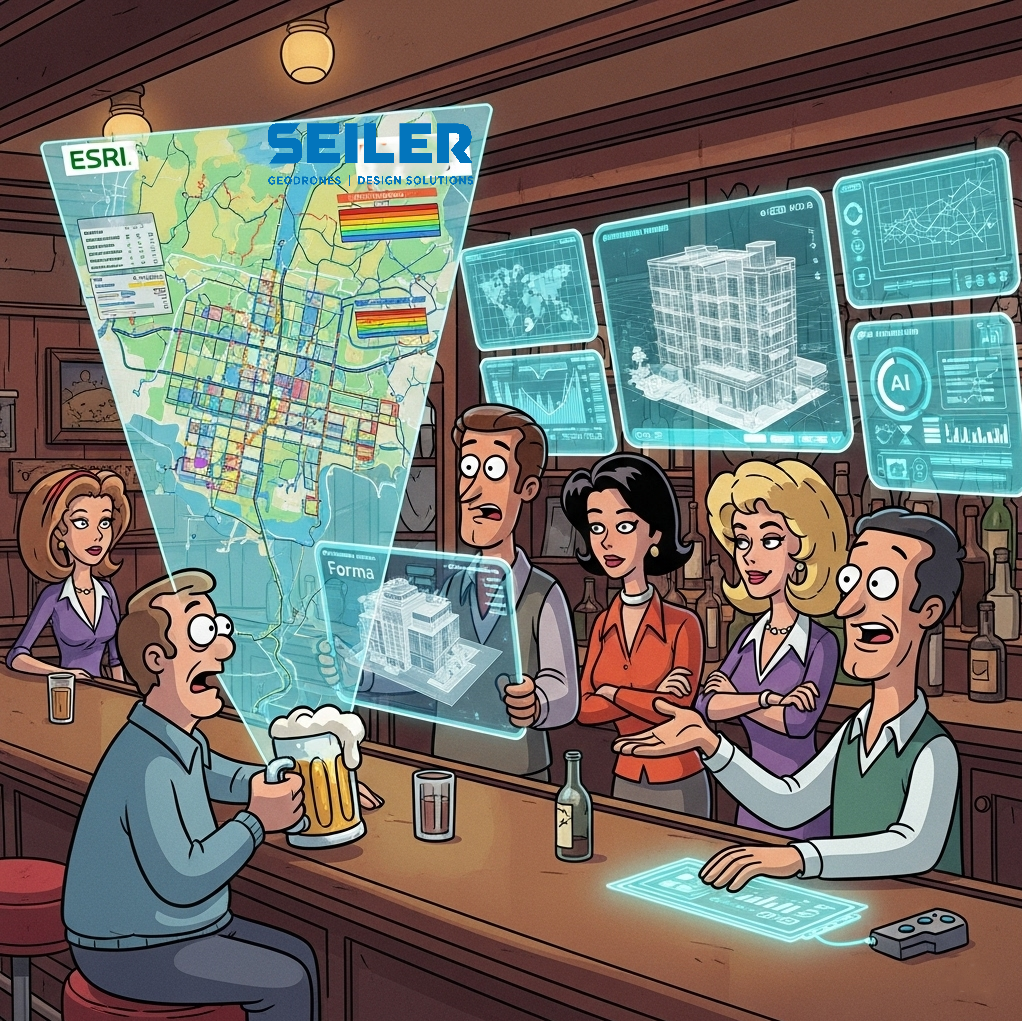🍻Alright folks, gather ’round the bar at good ol’ Cheers, where the beer is always cold, and the spatial data is surprisingly… hot? Tonight, we’re not talking about Sam’s romantic rendezvous or Norm’s legendary bar tab. Nope, we’re diving headfirst into the surprisingly hilarious and incredibly powerful world of Autodesk Forma and ESRI ArcGIS teaming up with AI to make your AEC and GIS workflows smoother than Carla’s sarcasm.
Pull up a stool, grab a virtual brewski, and let’s see how these tech titans are doing the digital dance, with a sprinkle of artificial smarts for extra flavor.

The Usual Suspects: Forma & ArcGIS Walk Into a Bar… 🚶♂️🚶♀️
You know ’em, you (might) love ’em.
- Autodesk Forma: Think of it as that sharp, forward-thinking newcomer to the Cheers gang. Maybe a bit like Rebecca, always looking for the innovative angle (and maybe a profit). Forma is all about early-stage design, spatial analysis, and understanding building performance before you even break ground. It’s cloud-based, collaborative, and increasingly infused with AI to help you make smarter, faster decisions about site selection, massing, and environmental impact.
- ESRI ArcGIS: This is your wise, been-around-the-block regular, like Sam himself, with a deep understanding of the local landscape (literally!). ArcGIS is the king (or queen!) of geographic information systems, handling everything from mapping and spatial analysis to massive datasets about our planet. It’s got the institutional knowledge of the entire city (and beyond!).
Woody’s Wonder AI: The Secret Sauce 🧠
Now, what’s making this dynamic duo even more potent? You guessed it: Artificial Intelligence. Think of AI in this context as Woody Boyd suddenly having a flash of unexpected brilliance (it happens!). It’s helping both Forma and ArcGIS analyze vast amounts of data, identify patterns, and provide insights that would take us mere mortals ages to uncover.
What’s in Their Tool Belts (and What Can You Do With It?):
- Forma’s AI-Powered Site Analysis:
- The Tool: Forma uses AI to analyze geospatial data (often coming from or overlapping with ArcGIS data) to understand site constraints and opportunities. This includes things like solar radiation, wind patterns, daylight potential, noise levels, and even zoning regulations.
- What You Can Do: Forget manually poring over maps and spreadsheets! Forma’s AI can quickly identify the best spots on a site for your building based on your performance goals. Want to maximize solar gain? Minimize wind impact? Forma’s got your back (Woody’s got your six… eventually).
- ArcGIS for Deeper Context:
- The Tool: ArcGIS provides the rich spatial context for Forma. You can bring in detailed information about surrounding buildings, infrastructure, demographics, environmental sensitivities, and much, much more.
- What You Can Do: Understand the bigger picture! See how your building design interacts with its surroundings, identify potential conflicts with existing utilities, and make informed decisions about accessibility and connectivity. It’s like knowing all the gossip at Cheers before anyone else walks in.
- AI Bridging the Gap:
- The Magic: AI is starting to help bridge the gap between these platforms, allowing for smoother data exchange and more integrated workflows. Imagine AI helping to automatically translate spatial data from ArcGIS into actionable insights within Forma, and vice versa.
- What You Can Do: Seamlessly move between macro-level site analysis in ArcGIS and micro-level building design in Forma. It’s like having a direct line between Sam’s local knowledge and Rebecca’s business acumen.
What This Opens Up (Beyond a Tab at Cheers!): 🚪
Thinking about jumping into this AI-powered spatial planning party? Here’s what you could unlock:
- Smarter Site Selection: Identify optimal locations based on data-driven insights, leading to more sustainable and efficient buildings. You’ll be picking the “best seat in the house” every time.
- Faster Iteration: Quickly test different design scenarios and understand their impact on building performance and the surrounding environment. It’s like trying out different guitar riffs until you find the perfect one.
- Improved Collaboration: Share spatial data and analysis results seamlessly between design teams, planners, and stakeholders. Everyone’s singing from the same (digital) song sheet.
- Enhanced Sustainability: Design buildings that are more energy-efficient, have better access to daylight, and minimize their environmental footprint. You’ll be the eco-rockstars of the AEC world!
- Informed Policy & Planning: For urban planners and policymakers, this combo offers powerful tools to analyze urban development patterns, assess infrastructure needs, and make data-driven decisions for smarter cities. It’s like Norm finally giving insightful advice at the zoning board meeting.
But Remember, Norm Still Needs a Beer (The Human Touch): 🤔
While AI is powerful, it’s not going to replace the need for human expertise and critical thinking. It’s a tool to augment our abilities, not replace them entirely. You still need the architect’s creative vision (Rebecca’s ambition!), the engineer’s structural know-how (Cliff’s… encyclopedic knowledge?), and the planner’s understanding of community needs (Diane’s… eloquent insights?).
Last Call for Innovation! 🔔
The convergence of Autodesk Forma, ESRI ArcGIS, and Artificial Intelligence is creating a truly exciting landscape for anyone involved in building and infrastructure. It’s like the Cheers gang finally figuring out how to use the internet (with potentially less disastrous results).
So, if you’re looking to make smarter, more sustainable, and more efficient decisions in your projects, maybe it’s time to pull up a virtual stool and explore the possibilities that Forma and ArcGIS, powered by AI, can offer. It might just be the “something, something, something… spatial” you’ve been waiting for! Now, who’s for another round of innovation? Contact us for more workflow topics.
(Disclaimer: No robots or overly enthusiastic postal workers were harmed in the making of this blog post.)


Leave A Comment